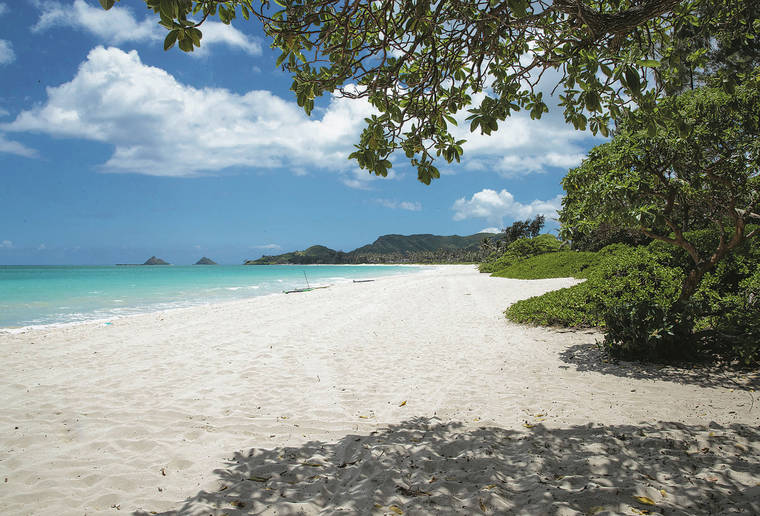No walking or running on Oahu beaches, state officials say

CINDY ELLEN RUSSELL / CRUSSELL@STARADVERTISER.COM
Kailua Beach was mostly devoid of beach-going activity Monday other than some people fishing or people heading straight into the water to avoid receiving citations.
Walking and running on Oahu beaches is now prohibited.
That’s the message the Honolulu Star-Advertiser has gleaned from the state Attorney General’s Office, the state Department of Land and Natural Resources and the city Department of Parks and Recreation.
“It’s currently against the law to walk or run on state beaches,” DLNR spokesman Dan Dennison said Saturday in a follow-up to an emergency order issued Friday by Gov. David Ige.
But only five beaches on Oahu are state beaches. They do not include Waikiki, Kailua, Waimanalo or most North or West Shore beaches.
To further muddle the issue, the news release announcing the governor’s new order said, “All beaches are closed, which means no sitting, standing, lying down, lounging, sunbathing, or loitering on beaches and sandbars.” It did not say “no walking or running.”
On Monday, in reply to questions from the Star-Advertiser, the Attorney General’s Office said in an email, “In Honolulu, the county and the state have the same rules — no use of the beach except to get to the ocean.”
Don't miss out on what's happening!
Stay in touch with breaking news, as it happens, conveniently in your email inbox. It's FREE!
You can walk across the beach to get into the ocean, but you cannot walk or run along the beach, appears to be the new rule.
“Basically, if you are in the water, you are fine,” said Nate Serota, spokesman for the city Department of Parks and Recreation.
Walking and running are now limited to sidewalks and streets — except in places that are closed, which means all city parks.
As of Monday, Honolulu Police Department officers had issued approximately 7,700 warnings and 2,800 citations for violations of Mayor Kirk Caldwell’s emergency order of March 18 that closed city beach parks, said Michelle Yu, HPD spokeswoman, adding, “The majority of the warnings and citations were given in closed parks.”
Many of these enforcement measures took place at city beach parks: For example, about 400 warnings and “a couple dozen citations” were issued at Kailua Beach Park, with approximately 61 warnings and seven citations made at Waimanalo Beach Park; a total of 1,400 warnings and 150 citations handed out in Kuhio, Queens and Kaimana beach parks in Waikiki; and about 770 warnings and two dozen citations given at Ala Moana Beach Park, Yu said.
Nevertheless, because the city and state allow people to cross parks and beaches to access the ocean for in-water exercise or fishing, confusion muddled the waters for Hawaii beachgoers over the weekend.
Laura Christensen, 70, a Michigan resident who was born and raised in Honolulu and has been staying with her mother in Hawaii Kai since February, said that she and her husband had been walking for exercise, wearing masks and keeping the recommended 6 feet of social distance from others whether on the beach or city sidewalks and streets.
“How is walking on the shoreline, and not stopping, any different from walking around the neighborhood and not stopping?” Christensen asked.
The difference, according to state and city officials, is that walking or running on beaches is now illegal.
Cindy McMillan, the governor’s communications director, forwarded an email from the Attorney General’s Office aimed at clarifying the issue.
“The state owns all beaches in Hawaii, which are all lands up to the high wash of the waves usually evidenced by the debris line or the vegetation line,” the statement said, noting that the state has given the counties jurisdiction over certain beaches, generally identified as county beach parks.
The attorney general’s Monday email said the Honolulu Police Department has jurisdiction to enforce state laws on state property, including state beaches, and that the state Department of Land and Natural Resources Division of Conservation and Resources Enforcement can also enforce laws on state beaches.
In an announcement released Saturday, DLNR reported that HPD and DOCARE officers were “patrolling beaches around Oahu, educating people on the temporary rules, aimed at preventing people from congregating on state beaches during the COVID-19 Opens in a new tab crisis,” and some DOCARE officers were writing citations.
Asked about the marble-paved Waikiki waterfront esplanade stretching from Queen’s Beach to the Ewa end of the Natatorium, where people can still be seen jogging, bicycling and strolling, particularly at sunset, Serota, of city Parks and Recreation, said it was closed.
“Concerning walkways, if they are in the park, then they are closed,” Serota said. “Sidewalks outside of the park, like along Kalakaua Avenue, remain open for transit.”
Christensen said she and her husband were happy to comply with the governor’s order, although they would miss walking on the beach, particularly at Waimanalo, which is so long that it was easy to meet her goal of 10,000 steps.
“I am all in favor of whatever it takes to keep this virus under control, so I understand why (the authorities) feel they have to do this, because I have seen people out in the last couple of weeks having picnics and sunbathing and stuff on the beach,” she said.
Still, she said, “it’s difficult walking in the neighborhoods, which are crowded. Hawaii Kai Drive is just as busy as can be.”
Driving by Waimanalo on Monday, the couple saw a few surfers and other people in the water but no one on the beach, “so I think people are getting the message,” Christensen said, adding she hoped everyone would follow the rules and that life could start returning to normal sooner than not.



